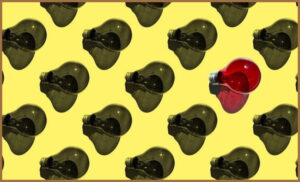Does innovation drive autism? This is the core question at the heart of a new autism theory from spectrum guru Simon Baron-Cohen... The post The Pattern Theory of Autism: How Autism, Innovation and Excellence Interlink appeared first on Autistic...
I am not a fan of scouring through the lives of famous historical figures and retroactively declaring them as autistic. Yet, there’s something inarguably fascinating about how, when we do post-diagnose our heroes, we often point to their obsessive tendencies as an indication of a spectrum-identity.
I don’t know about you but, to me, this signals that innovation, excellence and autism can all be viewed as closely interlinked. Yet, one look at the autism community will show that not every autist was born to be the next Albert Einstein, Leonardo DaVinci or Greta Thunberg – so how true can this be?
Well, according to a new theory from autism guru Sir Simon Baron-Cohen, the answer is still pretty darn close, wherein a better understanding of innovation in autism not only explains many unsolved mysteries of the spectrum, but may open up many new routes to unlocking an autist’s full potential.
This theory is called the systemising mechanism and it goes a little something like this…

What Is the Systemising Mechanism?
At some point or another, it’s safe to say that we have all marvelled at the capability of mankind; pondering how, in a fraction of the Earth’s history, we went from rubbing sticks for a fire to commanding vessels that allow us to master the sea, sky and land.
Well, according to a new autism theory, these feats were no mere coincidence as, fundamentally, the same ingenuity which allowed the first man to pick up a bone and turn it into a flute, is what still drives inspiration today: From astronauts in space to the skateboarders performing ‘ollies’ and ‘360s’ at the skatepark (yes, world-renowned autism researcher Simon Baron-Cohen uses the terms ‘ollies’ and ‘360s’ in his book. No, that never stops being weird).
Dubbed the systemising mechanism, this phenomenal force describes the complex thinking process which lies behind every discovery, big or small. However, by its author’s own admission, this capability of limitless creativity can easily be condensed into three looping words: ‘if’, ‘and’, ‘then’ – i.e a person’s ability to consider how:
If, something has happened, does happen or can happen…
and, this something is applied to something else..
then, what do the two things result in; how/why did it happen (i.e. back to the start)
Now, this may sound basic as we all unconsciously question these things in every action of every day. However, if the systemising mechanism is deemed to be real, it’s important that we do not undervalue its contribution to life as we know it. As, while for some it can be seen, in one’s ability to consider how:
‘If it is raining
and I go out without a coat
then I will get wet’
It’s equally important to remember how over 4000 years ago someone in China had the same thought and invented the umbrella.
But, hold on, what does any of this have to do with explaining autism and autistic potential you ask, well, in all honesty – Everything!

What the Systemising Mechanism Means for Our Understanding of Autism:
Let’s be frank, despite a handful of iconic movers and shakers, autistic people aren’t exactly known for our innovation. In fact, most autistic people are likely to be defined by a desire not to adapt and, instead, seemingly find comfort in keeping things routine and regimented, through repetitive/restrictive behaviours.
However, if the systemising mechanism theory is to be believed, then there is a lot more to an autistic person’s love of routine than meets the eye – wherein we don’t simply have a desire to do things over and over again, but instead autism could be an example of this systemising mechanism in hyperdrive: defined by an autist’s ability to constantly study the old in search of the new.
What I mean by this is that, while it’s well accounted how autistic people are very developed in the region of the brain which can spot consistencies, it then follows that we can be equally as impressive at spotting inconsistencies/differences – as they stand out like a sore thumb to our pattern-seeking brains.
Subsequently, under the view of the systemising mechanism, autism can be perceived not as a limiting condition to a person but, instead, one of endless possibility in narrow fields – as an autistic person isn’t familiarising themselves with their obsession but constantly testing the ‘if and then’ to find something new.
As demonstrated by the names up top, this can result in lucrative careers in information-heavy fields for many on the spectrum whilst, for others, our minds constant drive for more information results in stress, overload or meltdowns – as our minds are constantly comparing and contrasting information that our body is not ready to process.
Furthermore, for some in the community, the systemising mechanism could be interpreted as the reason we become incredibly socially unresponsive; to put it somewhat poetically we can become lost in our obsessions, forever searching for a Eureka moment that never seems to come.
So, what evidence do we have that supports this innovative idea of innovation and autism?

Evidence of the Systemising Mechanism:
Throughout The Pattern Seekers (the Baron Coen book for which the idea of a systemising mechanism is presented), there exists a range of evidence that supports the idea that autism is led by an ‘if and then’ drive.
Primarily, Baron-Cohen chooses to focus on the genetic factors which would prove this point: findings such as how, if autism is a genetic condition that promotes innovation, then it seems likely that autistic people will have parents who are working in an innovative field (which we often do), or how large families of autistic people can be found in hubs of innovation, such as Silicon Valley (which they also do).
However, the challenges of believing this theory don’t lie in the genetics of those who inherit the condition, but in how it explains the traits of the spectrum that we are already aware of.
For me, this presents a problem as, while innovation can explain mindsets like obsessive behaviours and communication challenges, the systemising mechanism doesn’t explain how autistic people can commonly face challenges like an uneasy stomach and weak or extreme interoception.
To give Baron Cohen credit, these traits aren’t completely ignored. Yet, instead of facing them head-on, they are somewhat sidestepped with comments that these challenges are a side effect of autism and not a core part (due to how they don’t impact everyone) – a response which makes me feel that Baron-Cohen has his rose-tinted autism glasses on; focusing on how autistic people can be raised even higher and ignoring those who may need support to find a level field first (something which is somewhat ironic considering how much stick he gets for supposedly being not neurodiverse-minded enough).
But does this mean we should completely disregard the theory? No! However, it does mean that I’m more inclined to believe that the systemising mechanism is in itself a symptom of autism, rather than the core component which drives our condition.
That said, I am very welcome to having my mind changed but, for Baron-Cohen and the team, it seems like the idea in itself could do with a little more ‘if and then’ consideration before we take another pass at calling the ‘if and then’ mind set the be and end-all of A.S.D.

Carry on the Conversation:
Do you believe that all of autism can be explained by the idea of a systemising mechanism? Let me know in the comments below. And, if you would like to hear about more exciting autism theories, why not check out my previous articles like The Intense World Theory of Autism Explained or Monotropism: The Most Accurate Autism Theory You’ve Probably Never Heard Of.
As always, I can also be found on Twitter @AutismRevised, on Instagram and via my email: AutisticandUnapologetic@gmail.com.
If you like what you have seen on the site today, then show your support by liking the Autistic & Unapologetic Facebook page. Also, don’t forget to sign up to the Autistic & Unapologetic newsletter (found on the sidebar on laptops and underneath if you are reading this via mobile) where I share weekly updates as well as a fascinating fact I have found throughout the week.
Thank you for reading and I will see you next time for more thoughts from across the spectrum.
The post The Pattern Theory of Autism: How Autism, Innovation and Excellence Interlink appeared first on Autistic & Unapologetic.


